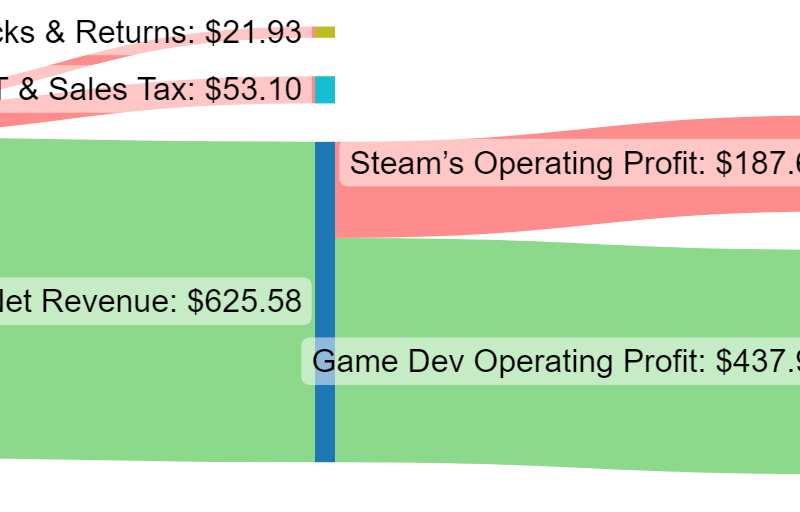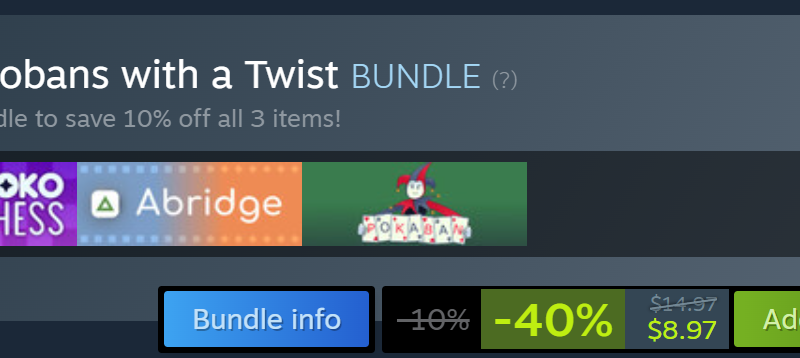Launch day…there’s nothing like. Excitement. Anxiousness. Joy. Relief. After days, weeks, months and years of hard work and sacrifice, it’s finally happening. Abridge is going to be released into the wild, wild west that is Steam. The only thing standing between me and my eager players are three magic words: “Release My App.” Once I entered them, the digital floodgates opened. The Abridge steam page should rapidly change from Coming Soon to the release price of $5.99 with a 10% launch discount. Wishlisters receive an email that Abridge is now available. I frantically refresh the steam page to check that the launch successfully went through. Once I confirmed it was available, it’s done. The emotions that rushed through me in that moment were filled with pride and happiness that I had done it. I accomplished a dream that I set more than 2 years prior: Release a Game on Steam.
While I cherished that moment in silence and later celebrated with my family over a nice pizza dinner, there were a bunch of tasks I had to do and questions I had to answer before releasing Abridge. They made sure that I was ready and that my launch day was fantastic. I wanted to share what I did before, during and after launch in the hopes that your launch day can feel as awesome as mine.
Before I get into the nit-gritty, I want to set some expectations. This is going to be a two part blog. There was too much I wanted to cover to fit in one post. In the first part, I am going to answer common launch questions I had and you probably do too. In the second part, I’ll discuss Abridge’s Launch plan and experience from 3 months before and to 6 weeks after, and review what went well and what didn’t.
Let’s hop right into it. What questions did I have about launching a game, here are the 5 big ones:
- When should you be thinking about launching your game?
- When should you release your game?
- What is the best timeframe, day, and time of day to have your release?
- Where do you release your game?
- How much do you sell your game for?
When should you be thinking about launching your game?
In the least possible sarcastic and most sincere tone I can project in writing…you should be thinking about this from the beginning. If your goals are like mine, they are to make a game and have players play it. The interconnect between them is to release the game. The release doesn’t have to be set in stone. But, it needs to be something that you are actively working towards. Have a general schedule of how you are going to get there and when that may be. It’s going to change and probably be an underestimate. That is totally fine. When I started Abridge, I thought it was going to take 6 months tops. It took me 28 months…😐.
The essence of the question though is when should you be thinking about it seriously. For me, I started to think about it seriously about 3 months in advance. I would recommend the same because of the quantity of stuff that needs to get done and the lead time to reach out to people. If your experience with releasing games is low, you’ll underestimate this by 2-3x (based on my experience). I’ll share more details in part two of this blog.
When should you release your game?
My short answer is…when it’s ready. I understand that this is not the case for everyone. Being a solo dev who is self funded, I have this flexibility. It gave me enough time to make changes, iterate and get feedback.
In reality, I moved my serious launches back 5 times. From January 2022 to March to June to September and finally to October. Each time, I sat down and made a 3 month plan. Wrote down a plan of what I thought needed to be done. If I found that the game wasn’t ready or I wasn’t far enough through the list, I moved the date back, updated the list, and repeated the process.
I remember chatting with a member from r/SoloDevelopment on Discord about Abridge and made the following comment:
I laugh at it now. But, boy was I wrong. That last 1% took 16 months. 😐🤣
What is the best timeframe, day, and time of day to have your release?
Timeframe wise, I researched this between January and March of 2022 and in August 2022. My worries were about not finding the best time to release. Instead it was to not conflict with any other major releases. As I kept delaying my release in Jan and March, I threw this out the window. When I finally picked October to release in August 2022. I did check again for October releases.
In hindsight, this doesn’t matter. I definitely overestimated the “splash” my game was going to have. I, like everyone else, want their game to sell, get reviews and make players happy. The gap between that train of thought and reality is a massive amount of fun things asking for player attention.
Let me share an example to show you what I mean. Take my release day, October 14th. There were 75 games released on Steam on that day (according to SteamDB here), 75!?! That’s crazy. The day before there were 77 Steam games released and the day after there were 17 Steam games (lower because it was a Saturday) (SteamDB). In the span of three days, there were 169 Steam games released and Abridge is just one of them. That doesn’t take into account the other Steam games that were released in October (1,202 were released according to VG Insights) or Steam games released in the previous months (10,907 were released in January 2022 to October 2022 according to VG Insights). The trend of games being released appears to be increasing and has been for the past couple years (VG Insights). In my opinion, it doesn’t show a sign of slowing down. Furthermore, that doesn’t take into account all the games that have been released before 2022, games other on PC platforms, games on other platforms (like mobile and console), and non-gaming activities like movies, television, sports, going outside, and hanging out with friends.
What was the point of saying all that? Two reasons. One to show the orders of magnitude that you are up against when releasing a game and to say this,… don’t worry about it. Especially if it is your first game and launch. Focus on your game. There are other ways to measure success besides financials, work on those. They are a lot more rewarding. 🙂 You don’t need to add another layer of uncertainty and another hurdle for your launch by trying to time it right.
I will say a general observation based on the monthly data from VG Insights, more games tend to be released in the second half of the year than the first. Less potential games to release alongside with.
Now for a day and time of day. There’s a tradeoff between launching when you think players will play your game and giving yourself time to resolve launch issues with Steam. I would recommend having your release at the end of the week on a Thursday or Friday in the early morning PST. My theory is that more people are likely going to play games during the weekends. Earlier morning because in theory it hits the major time zones at decent times. American audience in the early morning, European audience in the evening, and Asian audience in the late night. I also don’t recommend releasing on a weekend. Steam support is not available on weekends, only Monday through Friday. If you need help with your release or something goes wrong, you’ll need to wait till the following Monday to ask questions and resolve it. Releasing later in the week gives you a small chance to reach out if you need it. In my opinion, it is better to be safe than sorry.
Where do you release your game?
It is important to consider what platform that your game is going to be played on because it’s going to dictate the marketplaces that you can release your game on. There are three main platforms: mobile, console & handhelds, and PC. Each with their own respective marketplace.
Here are some examples marketplaces per platform:
- Mobile
- Google Play Store
- Apple App Store
- Console & Handhelds
- Sony’s Playstation Store
- Microsoft’s Xbox Store
- Nintendo’s Store & eShop
- PC
- Steam
- Itch.io
- Epic Games
- GOG
- Humble Bundle
I know there are probably many more options for marketplaces than I have listed. Microsoft is an exception because they are technically involved with PC and Console & Handhelds platforms. However, I mostly know them for Xbox with respect to gaming so I am going to keep them for the time being.
Now that we know about platforms and marketplaces, the next step is to choose which ones to want to release. How do you choose? There are a number of factors to consider: Goals, Time, Money, Skill, and Audience. Personally, the goal factor is the most important because it ultimately drives what you really want to do. The other factors will push and pull throughout your development and game dev journey. Evaluate them accordingly.
Why did I choose PC and releasing on Steam and itch.io? It aligned with my goals. When I started, my goal was to release games. Once I started researching how to actually build them, I had programming experience and occasionally played PC games on Steam. Starting on PC was a no-brainer. I was already familiar with the environment as a programmer and consumer. The quickest way I found to accomplish my goal with some advice from various YouTube channels was to use a game engine (Unity in my case) and do a game jam. Game jams commonly done on itch.io. That’s how I got introduced to using it as a marketplace. After I built and released a few little games there, I want to start something bigger and release a game where I had previously played games: Steam. I made a new goal: Release a Game on Steam.
If you don’t know where to choose or even where to start, do not worry! That’s totally normal. I would recommend a similar path I took. Go with PC and itch.io. PC has a lower barrier to entry, it is easier to release games, and it’s free. I haven’t released games on the other platforms so I don’t have first hand experience with them. Here are my thoughts from what I have heard and read. Consoles & Handhelds are harder to get approved to release in their marketplace, take more time to set up, and require special hardware (like game console dev kits). Mobile is easy to set up, the marketplaces are fairly saturated and may operate with different business models (freemium and/or free with ads and/or microtransactions).
How much do you sell your game for?
There is not one easy way to answer this as there are many things to consider. First, you can offer your game for free. That is an option. But, if you are asking this, you probably don’t want to do this. The most sound answer I can share is to research prices of similar games within the target genre on the target platform. Let’s breakdown what that means.
I’ll start with the last bit of “on the target platform.” The price of a game on mobile is vastly different from the price of a game on another Console & Handhelds and PC. In September 2022, the average Apple App Store game price in Sept. 2022 was $0.49 (Statista). In 2021, the average price of a Steam game was $7.80 (VG Insights).
Moving onto the next bit of “within the target genre”. Genres are a convenient way to categorize games. They help developers know they are building and players to know what they want to play. Some examples are action, adventure, FPS, and puzzle. Compare FPS games to FPS games, puzzle to puzzle and so on to get the best results. Comparing an RTS to an FPS to a puzzle game is like comparing apples to mangos to oranges. It doesn’t make a lot of sense. You’ll get data. What the data means, I don’t know. You’ll need to know what genre you want to build beforehand. There might be a subgenre as well. The same process above applies. The more specific, you can be the better.
Last bit is “research prices of similar games.” Go to a marketplace for your target platform and filter for the genre (and subgenre), you’ll have a long list of potentially games to review. However, I would not start noting down the prices of them. This is where many nuances that come into play. You’ll want to find the games that are as similar to your game as possible first. With this I mean, consider the some of the following: art style, music, sound FX, gameplay & mechanics, size of game, replayability, playtime, customization, level editors, multiplayer, gamepad/controller support, story, “juice”, demo, game “feel”, notable developer, reviews, size of developer, publisher. This is not an all inclusive list. Your game might not have some of them and that’s fine. The objective is that you are trying to establish what value your game has with respect to what is already in the marketplace.
For example, if you are a solo developer, try to find similar games by other solo developers, not made by teams. Teams can divide and conquer the game’s development. Furthermore, each team member is specialized in their portion of the development. Meaning having an artist, the game will look better. Having a game designer, it will have more interesting mechanics. So on and so forth.
When you find a game, that is similar enough. Jot it down in a spreadsheet. Write the name of the game, link to page, and the price. When you get to enough, you’ll start to get a better picture of what price to give your game. You can also jot down what is similar in a notes section so it’s easier to reference later.
Once you get enough similar games, make note of the popular games and the not so popular ones. Look at what they are doing well and not so well. What features do they have? Which ones improve the value and which ones do not? Read the reviews and see what players are saying about the game.
This will take time. It will be worth it though.
How I went about this with Abridge was researching similar games in the sokoban genre on Steam. There were a number of $1-$3 and $5-$10 sokoban games with varying levels of success (Steam). There were a couple similar related standouts such as Baba is You at $15 and Sokobond for $10. Upon reviewing the games, I felt totally comfortable listing Abridge at $5 based on the art style and game mechanics. I wanted to analyze the price a bit further with some different perspectives based on data, not just a feeling.
I focused on playtime and number of levels relative to price. I prioritized this because I thought my game was going to be too short relative to Steam’s Refund Policy (Steam). I observed about $1 correlated to 1 hr of playtime for Steam games, not only puzzle or sokoban games. (This is not a catch all by any means. There are definitely exceptions. Just an observation I made at the time.) Spoilers for level counts for Baba is You and Sokobond ahead… I noted that Baba is You has 226 levels and Sokobond has 144 levels. Dividing the price by levels gives us $0.06/level for Baba is You and $0.069/level for Sokobond.
Abridge was still in development while I was doing pricing calculations with these price/level’s. It was averaging out to $4. This was low relative to the $5 estimate I found earlier. Therefore, I decided to beef up the game by adding more levels and mechanics to provide more value.
The last nail in the coffin in how I arrived at the $6 price point was after reading 4 Tips to Help Your Price Your Indie Game by Chris Zukowski on howtomarketagame.com. It’s a good read and I highly recommend it. In his blog, one of his main points is that players don’t buy games at full price. They wishlist, wait and buy them at a discount, which is true as a PC player myself. To combat this, he suggests raising the base price of your game by 20 – 30%. My main takeaway and ah-ha moment from this point in the blog was to not think of the game at its full price. Think about price when it’s on a discount and then work backwards.
Using the $5 price from earlier and this 20% rule, we get (20% * $5) = $1 for the increase and adding that back in. We get a total of $6.
Ironically, as I was writing this, I went back and re-did the calculation using the price/level from Baba is You ($0.06/level) and Sokobond ($0.069/level) on Abridge’s 93 levels. It came out to $5.58 and $6.42, respectively. Averaging this out gives exactly $6, which is a pleasant and satisfying surprise. I will make a quick note that this doesn’t take into account the quality of the levels between all of the games. That’s a whole nother story. The sample size is also small with only three games.
Summary
Phew…That was a lot. Let’s wrap this up with a quick summary of the Q&A.
When should you be thinking about launching your game?
This should be on your mind from the beginning. Doesn’t have to be set in stone. It’s something you are actively working towards.
When should you release your game?
When it is ready. Keep track of the state of the game every 3 to 4 months. Keep revisiting it until you think it is ready.
What is the best timeframe, day, and time of day to have your release?
Don’t worry about the time frame for releasing your game. Especially if it’s your first one. Focus on completing the game and getting it out there. As for the day, shoot for later in the week, like Thursday and Friday, to strike a balance between potential players availability and getting Steam support. For the time, try an earlier morning PST to align with major time zones in the US, Europe, and Asia during decent hours.
Where do you release your game?
There are marketplaces available on the three major platforms: Mobile, Console & Handhelds, and PC. Each has their respective perks. Choosing which platform and marketplace to release on can come down to factors such as Goals, Time, Money, Skill, and Audience. If you are starting out, I recommend developing a game on PC and putting it on itch.io.
How much do you sell your game for?
My best recommendation is to take the time to research prices of similar games within the target genre on the target platform. When you have a price point picked out, think about adding 20% to it to account for players buying games at a discount, not a full price. Don’t forget offering your game for free for the experience is an option and just as valuable.
Thanks for reading my first real blog. 🥳 This was a lot of fun to research and write about. 😁
How have your game launches gone?
What were your biggest launch hurdles?
Have feedback about the blog?
Idea for future topics?
Let me know by emailing me at eventidegamesstudio@gmail.com or in the comments below.
I’ve been thinking about starting a Discord. Would you be interested in something like that?
In next month’s blog, I will finish up this two part-er by discussing Abridge’s launch plan and review what went well and what didn’t.
Check out Abridge if you have not already.
Cheers! See you next month! 😉




